[LeetCode] Trapping Rain Water II 收集雨水之二
Given an m x n matrix of positive integers representing the height of each unit cell in a 2D elevation map, compute the volume of water it is able to trap after raining.
Note:
Both m and n are less than 110. The height of each unit cell is greater than 0 and is less than 20,000.
Example:
Given the following 3x6 height map:
[
[1,4,3,1,3,2],
[3,2,1,3,2,4],
[2,3,3,2,3,1]
] Return 4.
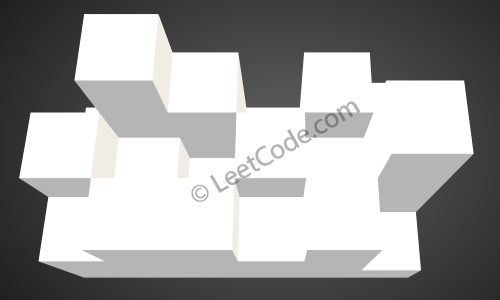
The above image represents the elevation map [[1,4,3,1,3,2],[3,2,1,3,2,4],[2,3,3,2,3,1]] before the rain.
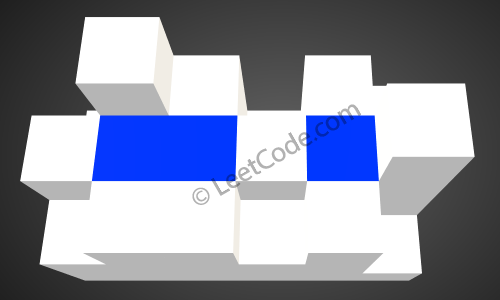
After the rain, water are trapped between the blocks. The total volume of water trapped is 4.
这道题是之前那道 Trapping Rain Water 的拓展,由 2D 变 3D 了,感觉很叼。但其实解法跟之前的完全不同了,之前那道题由于是二维的,我们可以用双指针来做,而这道三维的,我们需要用 BFS 来做,解法思路很巧妙,下面我们就以题目中的例子来进行分析讲解,多图预警,手机流量党慎入:
首先我们应该能分析出,能装水的底面肯定不能在边界上,因为边界上的点无法封闭,那么所有边界上的点都可以加入 queue,当作 BFS 的启动点,同时我们需要一个二维数组来标记访问过的点,访问过的点我们用红色来表示,那么如下图所示:
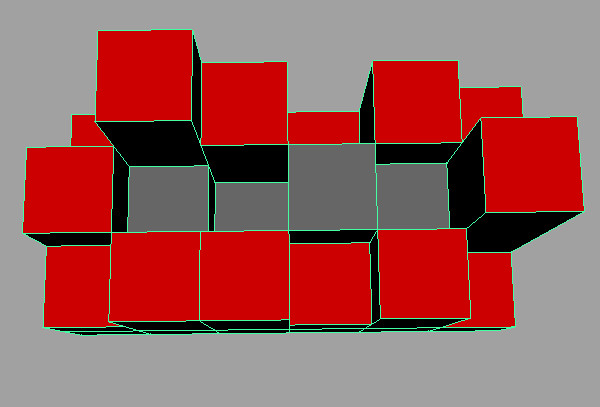
我们再想想,怎么样可以成功的装进去水呢,是不是周围的高度都应该比当前的高度高,形成一个凹槽才能装水,而且装水量取决于周围最小的那个高度,有点像木桶原理的感觉,那么为了模拟这种方法,我们采用模拟海平面上升的方法来做,我们维护一个海平面高度 mx,初始化为最小值,从1开始往上升,那么我们 BFS 遍历的时候就需要从高度最小的格子开始遍历,那么我们的 queue 就不能使用普通队列了,而是使用优先级队列,将高度小的放在队首,最先取出,这样我们就可以遍历高度为1的三个格子,用绿色标记出来了,如下图所示:

如上图所示,向周围 BFS 搜索的条件是不能越界,且周围格子未被访问,那么可以看出上面的第一个和最后一个绿格子无法进一步搜索,只有第一行中间那个绿格子可以搜索,其周围有一个灰格子未被访问过,将其加入优先队列 queue 中,然后标记为红色,如下图所示:
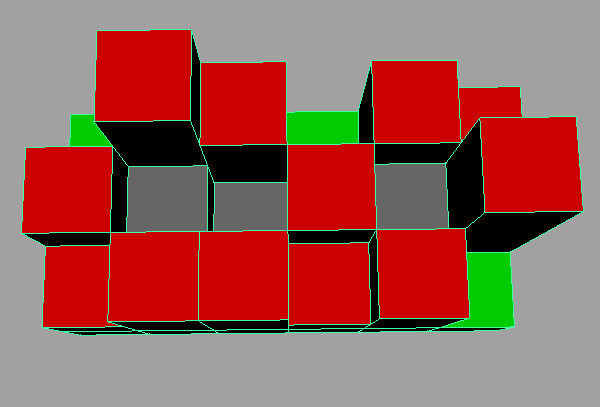
那么优先队列 queue 中高度为1的格子遍历完了,此时海平面上升1,变为2,此时我们遍历优先队列 queue 中高度为2的格子,有3个,如下图绿色标记所示:

我们发现这三个绿格子周围的格子均已被访问过了,所以不做任何操作,海平面继续上升,变为3,遍历所有高度为3的格子,如下图绿色标记所示:

由于我们没有特别声明高度相同的格子在优先队列 queue 中的顺序,所以应该是随机的,其实谁先遍历到都一样,对结果没啥影响,我们就假设第一行的两个绿格子先遍历到,那么那么周围各有一个灰格子可以遍历,这两个灰格子比海平面低了,可以存水了,把存水量算出来加入结果 res 中,如下图所示:
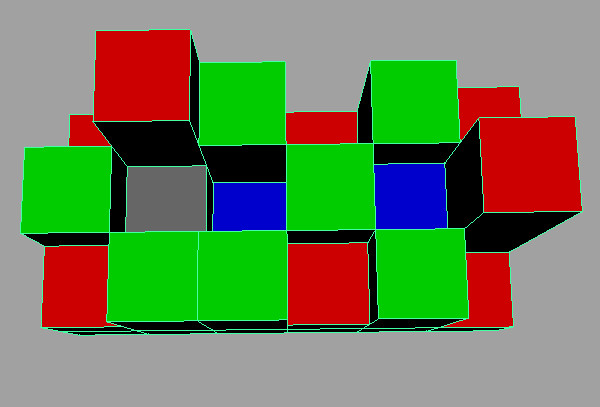
上图中这两个遍历到的蓝格子会被加入优先队列 queue 中,由于它们的高度小,所以下一次从优先队列 queue 中取格子时,它们会被优先遍历到,那么左边的那个蓝格子进行BFS搜索,就会遍历到其左边的那个灰格子,由于其高度小于海平面,也可以存水,将存水量算出来加入结果 res 中,如下图所示:

等两个绿格子遍历结束了,它们会被标记为红色,蓝格子遍历会先被标记红色,然后加入优先队列 queue 中,由于其周围格子全变成红色了,所有不会有任何操作,如下图所示:

此时所有的格子都标记为红色了,海平面继续上升,继续遍历完优先队列 queue 中的格子,不过已经不会对结果有任何影响了,因为所有的格子都已经访问过了,此时等循环结束后返回res即可,参见代码如下:
class Solution {
public:
int trapRainWater(vector<vector<int>>& heightMap) {
if (heightMap.empty()) return ;
int m = heightMap.size(), n = heightMap[].size(), res = , mx = INT_MIN;
priority_queue<pair<int, int>, vector<pair<int, int>>, greater<pair<int, int>>> q;
vector<vector<bool>> visited(m, vector<bool>(n, false));
vector<vector<int>> dir{{,-},{-,},{,},{,}};
for (int i = ; i < m; ++i) {
for (int j = ; j < n; ++j) {
if (i == || i == m - || j == || j == n - ) {
q.push({heightMap[i][j], i * n + j});
visited[i][j] = true;
}
}
}
while (!q.empty()) {
auto t = q.top(); q.pop();
int h = t.first, r = t.second / n, c = t.second % n;
mx = max(mx, h);
for (int i = ; i < dir.size(); ++i) {
int x = r + dir[i][], y = c + dir[i][];
if (x < || x >= m || y < || y >= n || visited[x][y]) continue;
visited[x][y] = true;
if (heightMap[x][y] < mx) res += mx - heightMap[x][y];
q.push({heightMap[x][y], x * n + y});
}
}
return res;
}
};
Github 同步地址:
https://github.com/grandyang/leetcode/issues/407
类似题目:
参考资料:
https://leetcode.com/problems/trapping-rain-water-ii/
https://leetcode.com/problems/trapping-rain-water-ii/discuss/89461/Java-solution-using-PriorityQueue
LeetCode All in One 题目讲解汇总(持续更新中...)
[LeetCode] Trapping Rain Water II 收集雨水之二的更多相关文章
- [LeetCode] 407. Trapping Rain Water II 收集雨水之二
Given an m x n matrix of positive integers representing the height of each unit cell in a 2D elevati ...
- [LeetCode] 407. Trapping Rain Water II 收集雨水 II
Given an m x n matrix of positive integers representing the height of each unit cell in a 2D elevati ...
- Leetcode: Trapping Rain Water II
Given an m x n matrix of positive integers representing the height of each unit cell in a 2D elevati ...
- [LeetCode] Trapping Rain Water II 题解
题意 题目 思路 我一开始想的时候只考虑到一个结点周围的边界的情况,并没有考虑到边界的高度其实影响到所有的结点盛水的高度. 我们可以发现,中间是否能够盛水取决于边界是否足够高于里面的高度,所以这必然是 ...
- [LeetCode] Trapping Rain Water 收集雨水
Given n non-negative integers representing an elevation map where the width of each bar is 1, comput ...
- leetcode 11. Container With Most Water 、42. Trapping Rain Water 、238. Product of Array Except Self 、407. Trapping Rain Water II
11. Container With Most Water https://www.cnblogs.com/grandyang/p/4455109.html 用双指针向中间滑动,较小的高度就作为当前情 ...
- LeetCode: Trapping Rain Water 解题报告
https://oj.leetcode.com/problems/trapping-rain-water/ Trapping Rain WaterGiven n non-negative intege ...
- [Swift]LeetCode407. 接雨水 II | Trapping Rain Water II
Given an m x n matrix of positive integers representing the height of each unit cell in a 2D elevati ...
- [leetcode]Trapping Rain Water @ Python
原题地址:https://oj.leetcode.com/problems/trapping-rain-water/ 题意: Given n non-negative integers represe ...
随机推荐
- objC与js通信实现--WebViewJavascriptBridge
场景 在移动端开发中,最为流行的开发模式就是hybmid开发,在这种native和h5的杂糅下,既能在某些需求中保证足够的性能,也可以在某些列表详情的需求下采用h5的样式控制来丰富内容.但是在大型 ...
- Oracle 集群】ORACLE DATABASE 11G RAC 知识图文详细教程之ORACLE集群概念和原理(二)
ORACLE集群概念和原理(二) 概述:写下本文档的初衷和动力,来源于上篇的<oracle基本操作手册>.oracle基本操作手册是作者研一假期对oracle基础知识学习的汇总.然后形成体 ...
- RAC 某节点不可用时,对应VIP是否可用
实验环境:RHEL 6.5 + GI 11.2.0.4 + Oracle 11.2.0.4 验证:RAC 某节点不可用时,其对应VIP是否可用?是否可用于连接数据库? [grid@jyrac2 ~]$ ...
- C#的扩展方法解析
在使用面向对象的语言进行项目开发的过程中,较多的会使用到“继承”的特性,但是并非所有的场景都适合使用“继承”特性,在设计模式的一些基本原则中也有较多的提到. 继承的有关特性的使用所带来的问题:对象的继 ...
- External Configuration Store Pattern 外部配置存储模式
Move configuration information out of the application deployment package to a centralized location. ...
- TeamCity : .NET Core 插件
笔者在<TeamCity : 配置 Build 过程>一文中提到 "TeamCity 内置支持几乎所有的 build 类型".在当今这个软件语言和各种框架飞速发展的时代 ...
- domReady的实现
我们都知道JQ的 $(document).ready(fn) 方法.可以在页面准备就绪后才执行脚本,该方法相比传统的window.onload 事件,它的优势体现于onload事件是需要等到页面中所有 ...
- Node学习笔记(一):stream流操作
NodeJs中谈及较多的可能就是Stream模块了,先写一个简单的ajax回调 $.post("index.php",{data:'aaa',order:'ccc'},functi ...
- C#开发微信门户及应用(33)--微信现金红包的封装及使用
我在上篇随笔<C#开发微信门户及应用(32)--微信支付接入和API封装使用>介绍为微信支付的API封装及使用,其中介绍了如何配置好支付环境,并对扫码支付的两种方式如何在C#开发中使用进行 ...
- Servlet 服务器性能提高--->数据库请求频率控制(原创)
首先我要说下我实现这个功能接口涉及到的业务和实现的详细流程,然后会说此接口涉及到的相关技术,最后会贴出注释后的详细代码, 这个接口涉及到的是 app上咻一咻功能,咻一咻中奖的奖品一共有七类,其中四类是 ...
